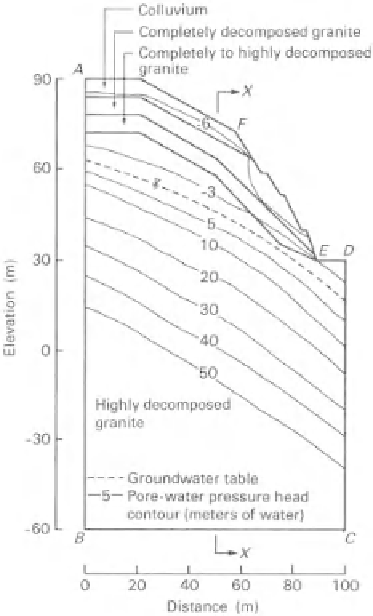Environmental Engineering Reference
In-Depth Information
The surface boundary
AFED
was specified as a flux
boundary. The applied flux was equal to the average annual
rainfall in Hong Kong, which is about 2080 mm/year, or
6
.
6
10
−
8
m/s (Anderson, 1983). However, only 10%
intake of the applied flux was allowed to enter on the steep
cut boundary,
FED
, which is protected by chunam. It was
assumed that water would run off the surface of the slope
when the applied flux was in excess of the amount of water
that could be taken in by the soil. It was anticipated that a
seepage face could develop with time near the base of the
slope along the boundary,
EF.
The pore-water pressure contours and the water table
under steady-state flux conditions are shown in Fig. 12.101.
The pore-water pressure profiles along the cross section
X
-
X
are illustrated in Fig. 12.102. The matric suction
deviates from hydrostatic conditions as a result of the
applied water flux at ground surface. The recharge condition
is maintained even in the dry season, as indicated from
field studies (Leach and Herbert, 1982; Sweeney, 1982).
The computed pore-water pressure under steady-state flux
conditions (Figs. 12.101 and 12.102) can be used to analyze
the stability of the slope. The Bishop simplified method was
used for all analyses. The analyses were performed using cir-
cular slip surfaces. The results are presented in Fig. 12.107
for various
φ
b
/
φ
ratios. When the negative pore-water pres-
sures are ignored (i.e.,
φ
b
/φ
=
×
Figure 12.102
Matric suction profile for section
X
-
X
under
steady-state moisture flux conditions.
0), the factor of safety is
equal to 0.9. The absence of signs of distress on the slope
would indicate that the actual factor of safety was greater
than 1.0. It is suggested that the negative pore-water pres-
sures are contributing to the shear strength of the soil. The
matric suction in the soil increases the factor of safety. The
factor of safety ranges from 1.0 to 1.4 as the
φ
b
/φ
ratio
varies from 0.25 to 1.0, respectively.
12.7.3 Seepage and Slope Stability Results under
High-Intensity Rainfall Conditions
The following transient analyses were performed to illustrate
the effect of a high-intensity rainfall for a long duration on
the stability of the steep slope shown in Fig. 12.97. The
rainfall rate was selected to be 1
.
30
10
−
5
m/s for the
duration of 480 min. The pore-water pressure distributions
corresponding to the simulated steady-state flux conditions
were used as the initial conditions for the transient seepage
analyses during the high-intensity rainfall.
The subsequent pore-water pressure distributions at various
elapsed times after the commencement of the high-intensity
rainfall are shown in Figs. 12.103-12.105. The upper portion
of the slope becomes saturated starting at the ground surface,
AF
, which is not protected by chunam (see Fig. 12.103). The
saturation front has penetrated to a depth of approximately
12m and extends to the region below the protected surface,
FE
, when the rainfall stops after 480min (see Fig. 12.96).
The final steady-state conditions are achieved at 1080min of
×
Figure 12.101
Initial groundwater conditions and pore-water
pressure contours.











Search WWH ::

Custom Search